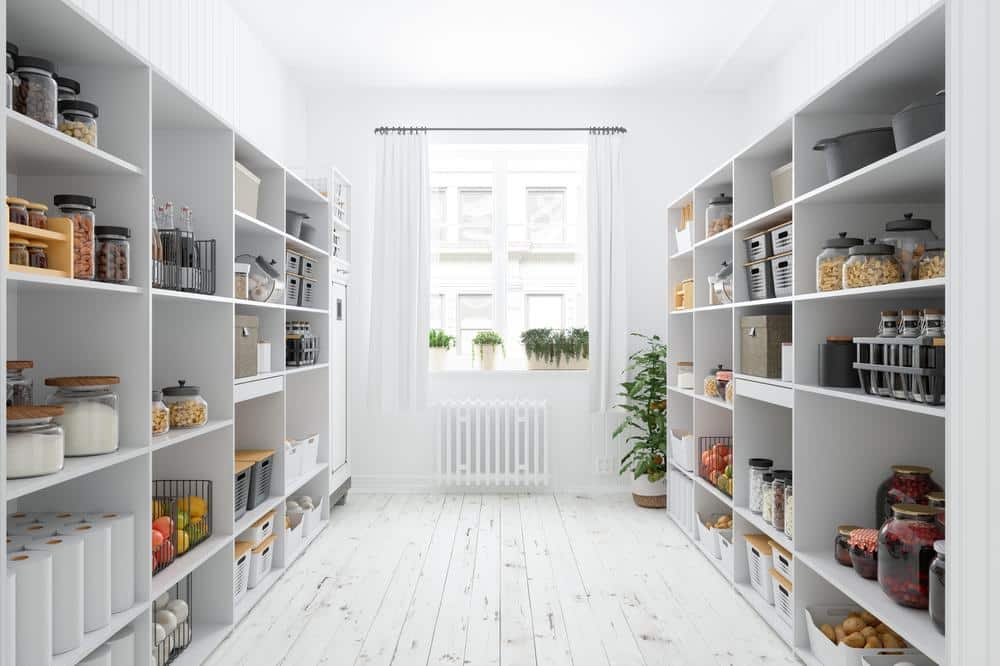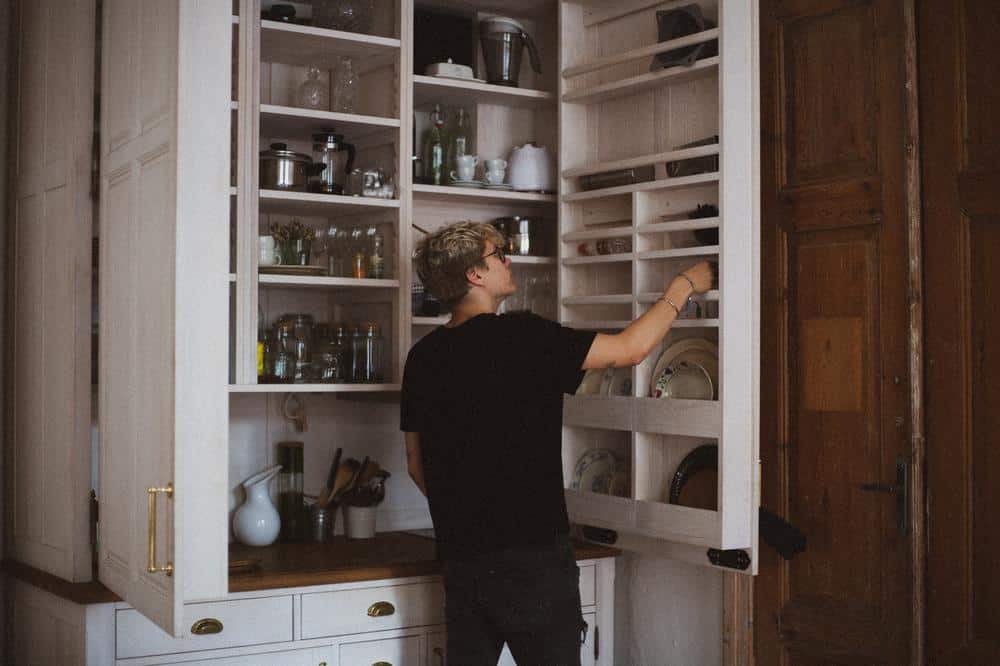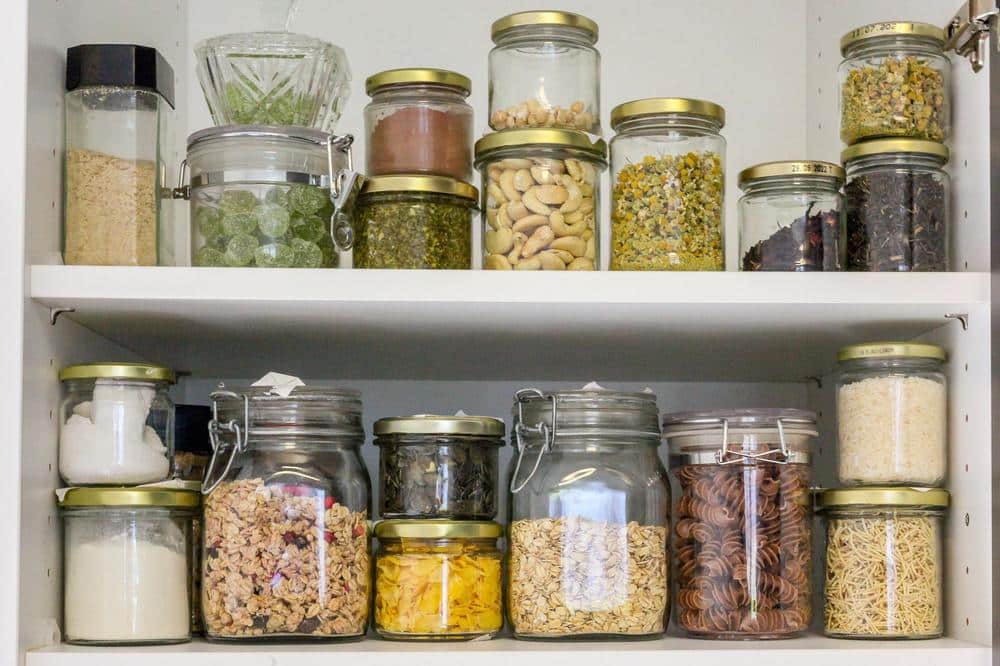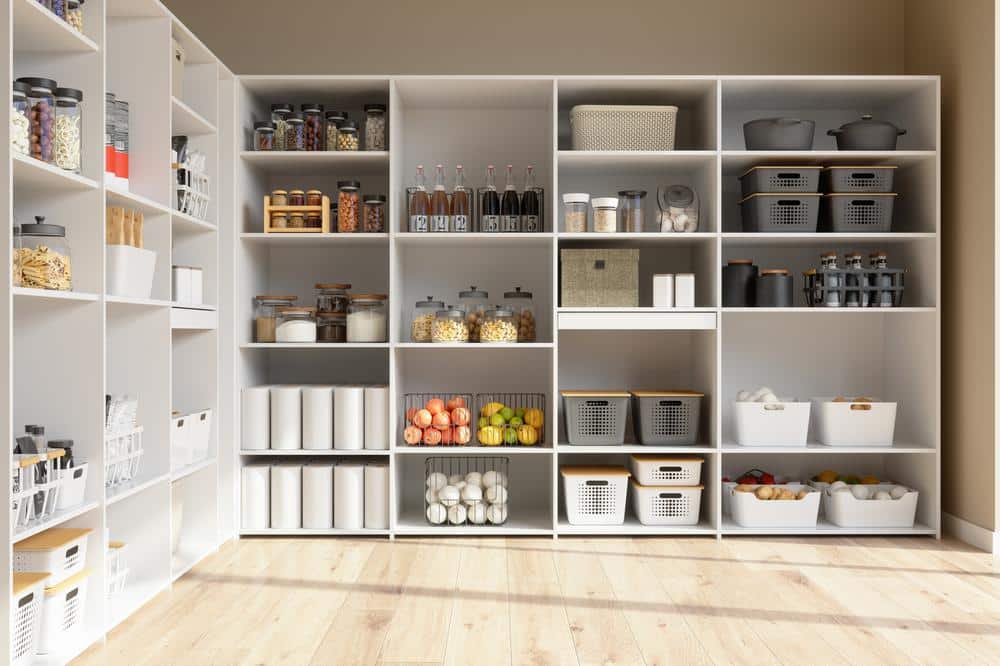A walk-in pantry is a luxury that frees up a significant amount of kitchen space. If you have a walk-in pantry in your home, you already know how much easier it is to store groceries. Large appliances can also be stored easily and have plenty of spare room. The disadvantage of walk-in pantries is that they can quickly become cluttered.
You can easily keep your pantry organized using bins, shelving, and a simple organization technique. Of course, your organization method will be determined by the size of your pantry and the types of groceries you purchase.
If you want to get the most out of your kitchen storage space, it’s time to start thinking outside the box with your pantry organizing ideas. Walk-in pantries are becoming increasingly popular as cooks look to maximize the potential of their kitchen space. With the right design, a walk-in pantry can double as a place to store food items, snacks, and other kitchen necessities while still looking great.
The three most important aspects of organizing a pantry are grouping, unpackaging, and sometimes repackaging. Here are 15 genius walk-in pantry organizing ideas you’ll want to try in your home. Continue reading for some fantastic pantry organization ideas.

1- Use Drawers In Walk-In Pantry Organizing
Table of Contents
- 1- Use Drawers In Walk-In Pantry Organizing
- 2- Arrange Items Neatly On Shelves In The Pantry
- 3- The Pantry Use Over The Door Organizers
- 4- Store Cans On Racks
- 5- Transfer Items To Airtight Containers in The Pantry
- 6- Use Storage Bins to Group Items in The Pantry
- 7- For Small Items, Use Sectioned Containers in the Pantry
- 8- Use Wire Baskets to Store Produce in the Pantry
- 9- Mount A Wine Rack in The Pantry
- 10- Purchase A Plastic Bag Organizer in The Pantry
- 11- Put In A Lazy Susan in The Pantry
- 12- Keep Sodas in the Dispenser in The Pantry
- 13- Make Use of Open Front Storage Bins in the Pantry
- 14- Transfer Products Into Glass Jars in The Pantry
- 15-Use a Chalk Board to Keep Track of The Pantry
- Invest in a Storage Cabinet for Pantry.
- Ensure Adequate Lighting
- In Closing
- How do I organize my walk in pantry shelves?
- How do you organize a pantry step by step?
- What should be in a walk in pantry?
- How to organize a walk-in pantry?
- How to organize a small pantry?
- How to organize a pantry with deep shelves?
- How do I maximize space in my walk in pantry?
- What is the best way to organize a walk-in pantry?
- How does Marie Kondo organize pantry?
- How do you organize a visible pantry?
- What’s the difference between a pantry and a butler’s pantry?
- Is it a good idea to have a walk-in pantry?
- What should be included in a walk-in pantry?
- How Do You Stage a Walk-In Pantry?
- In What Order Should a Pantry Be Organized?
- How Do You Professionally Organize a Pantry?
- How Do I Maximize My Walk-In Pantry Space?
- What Should a Walk-In Pantry Have?
- Should I Put a Door on My Walk-In Pantry?
The first pantry organizer we recommend is a set of drawers. Pull-out drawers make it possible to store groups of similar items that would be difficult to sort through on a shelf. The advantage of drawers over shelves is that you can see everything at once. You’ll be able to easily sort through and find exactly what you’re looking for.

2- Arrange Items Neatly On Shelves In The Pantry
Next, many walk-in pantries come equipped with sturdy shelves. Shelves are an important foundation in a pantry because they can support heavy food goods like cans and jars. You can store different products in sections next to each other to avoid searching through dozens of randomized cans.
You want to think of shelves in grocery stores as inspiration for stocking your pantry. If you have large appliances, it is a good idea to reserve the lower shelves for them. It is a lot safer for heavier items to be closer to the floor.

Walk-In Pantry Shelving
Paint the wooden shelves white to match the white walls in our pantry. Wire shelves can be a bit dangerous because they can allow items to fall through and smaller items may have a difficult time balancing on the wires. If you’re doing a pantry makeover or building, I recommend using wooden shelves. (Wire shelves, of course, are also a great choice.) To prevent items from falling through the wire shelves, you can also use a shelf liner.
Wrap-Around Shelving System
How can you organize your walk-in pantry with shelving? Make sure that everything you need is located at a specific place in your walk-in pantry. A reliable shelving system ensures you don’t waste time looking for a specific item and avoids re-purchasing items you already have. When you know exactly where to find what you’re looking for, you don’t waste time looking for an item and use your pantry more efficiently. You can store heavy or infrequently used items on lower shelves and commonly used items within reach. It is a smart investment that allows you to store heavy or seldom-used items on lower shelves and more commonly used items in arm’s reach.

3- The Pantry Use Over The Door Organizers
Over-the-door organizer would look great in a walk-in pantry. This is where you can keep everyday items that you want to have easy access to. If you have a pet, you can store items such as treats or canned food. These baskets can also be used to store sauces, jams, rice, beans, and anything else you need for a quick meal.
Organize by Expiration Date
When restaurants and grocery stores stack their perishable items, first in, first out is how it works. You should use up the older items first, save money and reduce waste, and encourage you to consume the open packages before consuming the new ones. You can also keep your walk-in pantry organized in this manner and clean it out more efficiently since you know the items on the top are affected first.

4- Store Cans On Racks
The rack can then be used to store and dispense cans. The design is slanted for the cans behind to roll forward. If you have a lot of cans that are all the same size, you can get multiple racks and stack them on top of each other. Some racks are adjustable and can hold a variety of can sizes. For much larger cans, you’ll want to keep them on shelves.
5- Transfer Items To Airtight Containers in The Pantry
When organizing pantry items, you may discover that boxes take up a significant amount of space. If you empty boxes of the same product into one container, you will save a lot of space. When you buy containers in a set, they will all be the same shape, making it easier to organize them together. These containers can be used to store anything from candy to spaghetti.
6- Use Storage Bins to Group Items in The Pantry
Following that, you can store food in storage bins like this one. You can see what you’re grabbing because they’re labeled, which is important if you have a lot of bins. These can be used to store individually packaged foods when organizing. Small snacks, juice pouches, and any other wrapped food can be stored in these bins, for example.

7- For Small Items, Use Sectioned Containers in the Pantry
Then there are storage bins in the same family as storage bins. You should use these to separate flavor variations; these containers can easily sort items such as granola bars. You can also find multilevel storage, as shown in the image above. Because of the difference in height, it is easy to see what is in the back.
8- Use Wire Baskets to Store Produce in the Pantry
Wire baskets are essential for storing fresh produce in your pantry. You will be able to store perishables in a convenient location. Unlike the previous plastic storage bins, this one has ventilation. These baskets are ideal for items like potatoes and onions that require airflow to extend shelf life.
To extend the shelf life of fruits and vegetables, avoid exposing them to direct light. Store produce in shaded areas such as drawers if your pantry has a window or receives a lot of sunlight.

9- Mount A Wine Rack in The Pantry
You should keep some on hand in the pantry if you drink wine. Instead of taking up shelf space, consider utilizing wall space. This wine rack hangs on the wall, keeping it out of the way and making it easy to read the labels.
10- Purchase A Plastic Bag Organizer in The Pantry
You most likely have an abundance of plastic bags. You could save them to use as small trash bags or to reuse while shopping. In any case, storing them in a dispenser like this will keep your pantry much more organized than storing them in a separate grocery bag.

11- Put In A Lazy Susan in The Pantry
If you’re not sure what a lazy susan is, it’s a circular platform that can rotate 360 degrees. These are ideal for storing more delicate items such as glass bottles of oil and vinegar or small spices. Lazy susans are best used in the corners of your pantry shelves to make it easier to reach items without having to move things around. Just be careful not to spin them too quickly!
12- Keep Sodas in the Dispenser in The Pantry
Sodas stored in a single layer on a pantry shelf can take up a lot of space. This rack is one can wide and easily holds a case of sodas. This rack also has a rolldown dispensing system that makes refilling a breeze. Keeping a few of these in the pantry for canned drinks will save you from having to reach back on a shelf for drinks.

13- Make Use of Open Front Storage Bins in the Pantry
Open front storage bins allow you to reach into a container without opening a drawer. You can keep both boxes and cans organized and easily accessible. These containers can be stacked and used as open-faced drawers in your pantry. Clear plastic bins are an excellent choice because they allow for complete visibility.
14- Transfer Products Into Glass Jars in The Pantry

The most popular way to go plastic-free in your kitchen is to use glass. Glass containers are ideal for long-term storage of dry foods such as oats, sugar, and rice. They are also healthier than plastic containers because they are made of natural materials containing no toxins. You will need to be more cautious with glassware than with plastic containers.
If you use glass containers, you should use a shelf liner. Shelf liners make shelving more secure by providing an anti-slip surface. You run the risk of glass sliding and breaking if you don’t use a liner.
15-Use a Chalk Board to Keep Track of The Pantry
The best way to keep your pantry organized is a chalkboard or notepad that can be kept in your pantry or outside the door. You can jot down grocery lists, expiration dates, and, of course, meal ideas.
Invest in a Storage Cabinet for Pantry.
If you’re looking for a way to store all of your food items in one place, a storage cabinet for the pantry is a great solution. Storage cabinets for pantries are designed to fit into the corners of a space, providing the perfect spot to store items like canned goods, spices, and even bulk items like flour.
Ensure Adequate Lighting
The dingy pantry lighting is significantly impacting the impression of this area. If you have to strain to read labels or discern whether the room is clean or messy, the lighting in the pantry must be revamped. It might be as simple as changing to a brighter bulb, or perhaps the whole fixture should be replaced with a fashionable and eye-catching ceiling light. Spending a bit of money on the lighting makes a huge difference in the pantry’s appearance.
In Closing
These pantry organization tips apply to all sizes of pantries. Organizing your pantry is a simple task. It can be as simple as gathering groups of similar items and placing them in baskets. The most important aspect of organizing is that items are easy to remember and locate.
Having a walk-in pantry requires some effort to maintain over time, especially if you have children who use the shelves daily. Your pantry will remain organized as long as you clean up and return everything to its proper place after shopping.

How do I organize my walk in pantry shelves?
Maximizing space in a walk-in pantry can be an overwhelming task, but with careful planning and organization, you can maximize the available storage within your pantry.
The first step is to assess what type of items you will be stored in your pantry. If food items need to stay cold or frozen, then make sure to place them towards the back, so they don’t get too warm. Similarly, if you are storing dry goods such as cereals and grains, keep those on shelves away from any moist air coming from refrigerated items.
To maximize vertical storage space and empty wall space in a small walk-in pantry area, try using simple organizational tools such as stackable drawers or trays, which can store multiple types of smaller objects like cans and boxes without taking up floor space. Alternatively, invest in multiple shelving units that can easily hold many canned goods or bulk food containers at different heights on the walls. You may also find there is room for hanging baskets above shelves which are perfect for frequently used ingredients like herbs & spices or baking materials, depending on your preferences!
How do you organize a pantry step by step?
Organizing a pantry can be an overwhelming task, but it can be done quickly and painlessly with the right steps. Here are some step-by-step instructions to help you get started:
- Designate areas for food categories – Start by deciding where in your pantry you will designate areas for specific food types like baking ingredients, canned goods, condiments, snack foods, and cereals. Place frequently used items on the lower shelves and rarely used up high or further back so they’re out of reach. This helps make your pantry look tidier while providing easy access to everyday items.
- Clear everything out – Take all the contents out of your pantry and thoroughly clean them before putting anything back in. Wipe down shelves and wipe any spills off containers with a wet cloth or disinfectant spray if necessary.
- Group similar items together – Once your pantry is clean, start grouping similar items together into categories like soup/rice/beans; canned vegetables; snacks; breakfast cereal, etc., so that you know where each item should go when it comes time to put them away later on (this makes things easier). As you do this, work through expired products, as these need to be disposed of safely!
What should be in a walk in pantry?
With limited space in your kitchen, a walk-in pantry can be the perfect solution for keeping all the food you need on hand. Whether it’s canned goods and dry groceries or snacks and beverages – if there is any storage solution needed, then this small room offers plenty!
How to organize a walk-in pantry?
Organizing a walk-in pantry is an excellent way to maximize storage and utilize every inch of your space. To get started, here’s what you’ll need:
- A clutter buster: Decluttering your pantry can be daunting, but keeping it organized in the long run will make it much easier to maintain. The first step is to take everything out, go through each item and decide if you want to keep or donate them; this will help create a blank canvas for your new organizational system.
- Containers & baskets: Utilize containers and baskets to group items together that have similar uses, such as baking supplies, snacks, pasta/rice, etc.; this will give you easy access when needed and makes use of the vertical space by hanging baskets on the walls or taking advantage of shelving units.
- Labels: Labels are helpful for organizing different types of items and serve as reminders for food rotation so that nothing gets forgotten about in the back corner!
- Deep Shelves & Drawers: Invest in deep shelving units with drawers, so cans from soup to vegetables are easily accessible while maximizing available space (especially important with smaller walk-in pantries). Pullout drawers also help keep all those small odds & ends in check without adding extra bulkiness or wasting floor space!
How to organize a small pantry?
Organization is key to a tidy pantry. A well-organized pantry can help make your space more efficient and free up valuable space for other items you may need. Here are some tips for organizing a small pantry:
Start with a Clean Slate: Before beginning the organization process, it’s important to start with an empty canvas. Take all the items out of your pantry and clean them thoroughly with soapy water or a multipurpose cleaner. This will give you an idea of where everything goes and how much storage space you have available.
Purge Excess Items: Now that everything has been removed from your pantry, take this opportunity to get rid of anything expired or no longer used regularly (such as canned goods, packets, etc.). Doing this decluttering step before organizing will help ensure that only needed items remain in the space moving forward.
How to organize a pantry with deep shelves?
Organizing a pantry with deep shelves can be tricky, but proper planning is definitely achievable. Here are several tips to get you started:
Start by measuring the dimensions of your shelves and the objects you’ll be storing in them. This will help ensure that everything fits properly and that you have an accurate idea of how much storage space is available for organizing items.
Consider investing in shelf risers or stackable containers to use what would otherwise be wasted vertical space on the shelves. This can also help separate ingredients, so they don’t get mixed up and make it easier to find what you need quickly when cooking or baking.
Sort food items into categories such as canned goods, snacks, baking materials, and spices, so these items stay neat and organized within their designated areas rather than being scattered throughout the pantry disorderly due to their size difference from smaller condiments to larger cereals and grains. Label each section for easy reference when the time comes to fetch an ingredient for cooking a meal or snack!
How do I maximize space in my walk in pantry?
Maximizing space in a walk-in pantry takes some forethought and creativity, as well as implementing certain organizing tactics. Here are some general tips to make the most of your storage:
- Use Clear Containers: To maximize space, opt for clear containers — like glass jars or plastic bins — to store dry goods and other items that can’t be stored on shelves. This will make it easy to quickly identify what’s inside without opening each container. Organize similar items, such as pasta or cereals; if you label them with contents on the lid, they’ll be easier to find when you need them!
- Utilize Vertical Space: Shelving is great for storing items horizontally, but don’t forget about vertical walls! Install shelves and racks along your pantry walls to take full advantage of unused space with stacked rows instead of just one layer deep on a single shelf. Plus, using wire basket-like hangers will let air move better throughout the pantry, helping keep food fresh longer.
- Designate Zones: The best way to keep an organized kitchen is by assigning zones for different categories—this rule applies perfectly to a new walk-in pantry too! For example, create zones based on how often items are used; dedicate higher spaces towards more frequent foods such as breakfast items, while snacks could be kept lower away from kids reach. Additionally, you could designate areas “just for Dad” where he has easy access to his favorite things! This also helps family members locate their desired items faster and reduces clutter from everyone taking out different things at once.
What is the best way to organize a walk-in pantry?
The best way to organize a walk-in pantry involves the following steps:
- Declutter: Remove all items from your pantry and sort them into categories like “keep,” “donate,” or “discard.” Check expiration dates and discard any expired products.
- Categorize: Group pantry items by type, such as canned goods, baking supplies, snacks, spices, and beverages.
- Plan your layout: Designate specific shelves or areas for each category, placing frequently used items within easy reach and less frequently used items on higher shelves or in less accessible areas.
- Use appropriate storage solutions: Opt for clear bins, baskets, or containers to store and display items in an organized manner. Consider using airtight containers for dry goods to maintain freshness and prevent spills.
- Label containers: Clearly label bins, baskets, or containers to easily identify contents and encourage consistent organization.
- Maintain organization: Regularly declutter, restock, and reorganize your pantry to keep it tidy and functional.
How does Marie Kondo organize pantry?
Marie Kondo recommends organizing the pantry by following these principles:
- Declutter and discard items that no longer spark joy or serve a purpose.
- Store items in clear, airtight containers to maintain freshness and visibility.
- Use boxes or bins to group similar items together.
- Arrange items vertically, so everything is visible at a glance and easy to access.
- Label containers and shelves to maintain consistent organization.
- Keep the pantry tidy by regularly decluttering and reorganizing.
How do you organize a visible pantry?
To organize a visible pantry:
- Declutter and keep only essential items that are in good condition and visually appealing.
- Use uniform, clear containers or jars for storing dry goods, creating a cohesive and attractive appearance.
- Group items by type or category, arranging them in an orderly and symmetrical manner.
- Label containers clearly and neatly for easy identification and to maintain a clean look.
- Consider using decorative baskets, bins, or trays to store similar items together and add visual interest.
- Regularly clean and reorganize the pantry to ensure it remains tidy and visually appealing.
What’s the difference between a pantry and a butler’s pantry?
A pantry is a dedicated storage space, typically located near the kitchen, designed to store food, kitchen supplies, and sometimes small appliances. Pantries can be walk-in closets or cabinets with shelves and other storage solutions to accommodate various items.
A butler’s pantry, on the other hand, is a separate room or area traditionally used for storing fine china, glassware, and silverware, as well as for preparing and staging food before serving. Butler’s pantries often feature additional countertops, cabinetry, and even sinks or dishwashers to assist with food preparation and cleanup during entertaining.
Is it a good idea to have a walk-in pantry?
Having a walk-in pantry can be a great idea if you have the available space and need ample storage for food, kitchen supplies, and small appliances. A walk-in pantry offers several benefits:
- Increased storage capacity: Walk-in pantries provide more storage space compared to traditional cabinets or shelves.
- Improved organization: With dedicated shelves and storage solutions, walk-in pantries make it easier to keep items organized and accessible.
- Enhanced functionality: Walk-in pantries can improve the functionality of your kitchen by keeping frequently used items within easy reach and reducing clutter in the main cooking area.
- Customization: Walk-in pantries can be designed and customized according to your specific storage needs and preferences.
What should be included in a walk-in pantry?
Items typically included in a walk-in pantry are:
- Shelving: Adjustable shelves to accommodate various sizes of items and allow for easy reorganization.
- Bins and baskets: Clear or labeled bins and baskets to group similar items together and keep them organized.
- Airtight containers: Clear, airtight containers for storing dry goods, maintaining freshness, and preventing spills.
- Lazy Susans: Rotating trays for easy access to items stored in corners or hard-to-reach areas.
- Hooks or racks: Hooks or racks for hanging items such as aprons, reusable bags, or kitchen towels.
- Lighting: Adequate lighting to ensure visibility and easy navigation within the pantry.
- Labels: Clear labels for containers and shelves to maintain consistent organization and easily identify contents.
How Do You Stage a Walk-In Pantry?
Staging a walk-in pantry requires careful planning and organization. Start by decluttering and removing any unnecessary items. Then, organize the remaining items by category, such as baking supplies, canned goods, and snacks. Use clear containers for loose items like pasta or rice so they’re easily identifiable. Lastly, ensure that your pantry is well-lit and clean, creating an inviting and functional space.
In What Order Should a Pantry Be Organized?
Organize your pantry based on how you use it. Frequently used items should be at eye level or within easy reach. Group similar items together – for instance, baking ingredients in one section, canned goods in another. Store heavier items at the bottom and lighter ones at the top. Also, have a dedicated space for kid-friendly snacks if you have children.
How Do You Professionally Organize a Pantry?
Professional pantry organization involves an efficient use of space and easy access to items. Use organizers like bins, baskets, and tiered shelves to maximize space. Label everything clearly, especially if you’re using containers. Rotate your stock routinely to avoid expired products – always place newer items at the back and older ones at the front. A professionally organized pantry should not only look good, but also make meal preparation quicker and easier.
How Do I Maximize My Walk-In Pantry Space?
To maximize your walk-in pantry space, consider installing adjustable shelves to cater to items of different sizes. Utilize the door space by adding racks or over-the-door organizers. Use clear, stackable containers to save shelf space and keep your pantry tidy. Also, consider adding a turntable or lazy Susan for hard-to-reach corners.
What Should a Walk-In Pantry Have?
A walk-in pantry should have well-organized storage spaces, good lighting, and ventilation to keep food fresh. It should include shelves of varying heights to accommodate different items, clear containers for bulk goods, and a system for keeping track of what you have and what you need. It’s also helpful to have a small countertop or workspace for meal prepping.
Should I Put a Door on My Walk-In Pantry?
Whether or not to put a door on your walk-in pantry depends on your personal preference and the design of your kitchen. A door can hide clutter and keep your pantry items out of sight, making your kitchen look tidier. However, if you prefer easy access to your pantry, or if your pantry is well-organized and aesthetically pleasing, you might opt for an open pantry or a door with glass panels.

Experienced Executive Assistant with a demonstrated history of working within the furniture industry. Skilled in furniture styling, visual communication, project management, and proficiency with Adobe Creative Suite. Strong arts and design professional with a (BA) Creative Direction for furniture design focused on Industrial Design from School of the Art Institute of Chicago.
![How To Organize A Walk-In Pantry [With 15 Great Ideas!]](https://bienalclosets.com/wp-content/uploads/2022/01/pexels-rachel-claire-5490824-1-scaled.jpg)














